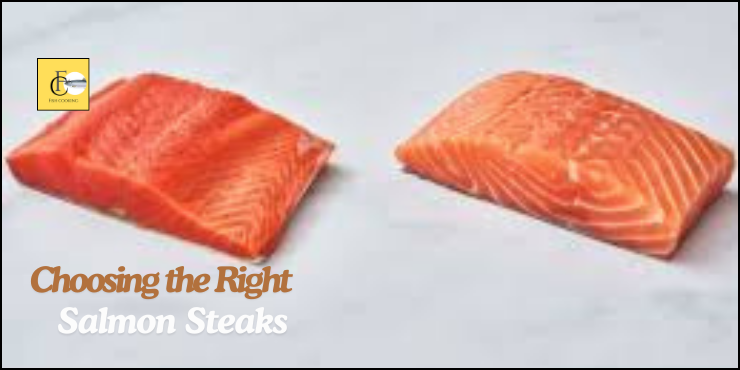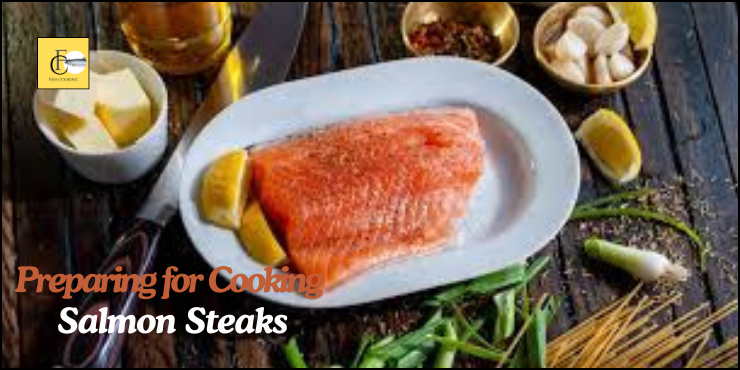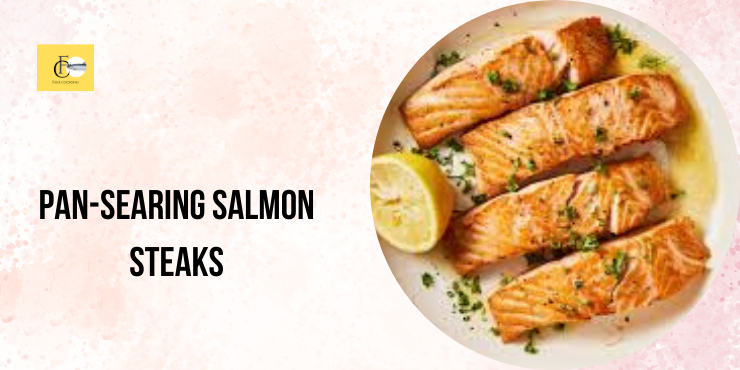Cooking salmon steaks can seem intimidating, but it’s easier than you might think. This guide will walk you through everything you need to know to cook delicious, restaurant-quality salmon steaks at home.
Choosing the Right Salmon Steaks

First things first, selecting the right salmon is crucial.
Fresh vs. Frozen
Fresh salmon is wonderful if you can get it, but frozen salmon is a great alternative and often just as nutritious. When buying frozen, make sure the steaks are vacuum-sealed and check for any signs of freezer burn.
Wild-Caught vs. Farm-Raised
Wild-caught salmon tends to have a richer flavor and firmer texture, while farm-raised salmon is often more affordable and available. Both can be delicious; it just depends on your preference.
Selecting the Perfect Cut
Look for salmon steaks that are bright and firm, with a vibrant color and no off-putting smell. The flesh should be moist but not slimy, and the skin should be shiny and tight.
Preparing for Cooking Salmon Steaks

Before you start cooking, proper preparation is key.
Thawing Frozen Steaks
If you’re using frozen salmon, thaw it in the refrigerator overnight. If you’re in a hurry, place the sealed steaks in a bowl of cold water to thaw them quickly.
Cleaning and Patting Dry
Rinse the salmon steaks under cold water and pat them dry with paper towels. This helps remove any scales or residual slime and ensures a better sear.
Seasoning Basics
Keep it simple with salt and pepper, or get creative with your favorite herbs and spices. A drizzle of olive oil helps to keep the steaks moist during cooking.
Essential Tools and Ingredients
Make sure you have the right tools and ingredients on hand.
Kitchen Tools Needed
- Non-stick skillet or grill pan
- Tongs
- Baking sheet
- Meat thermometer
- Aluminum foil
Key Ingredients
- Fresh or frozen salmon steaks
- Olive oil or butter
- Salt and pepper
- Lemon or lime
- Fresh herbs (like dill, parsley, or thyme)
Pan-Searing Salmon Steaks

Pan-searing is a quick and flavorful way to cook salmon steaks.
Step-by-Step Guide
- Heat a non-stick skillet over medium-high heat.
- Add a tablespoon of olive oil or butter.
- Place the salmon steaks in the skillet, skin-side down.
- Cook for 4-5 minutes, then flip and cook for another 4-5 minutes.
Tips for Perfect Searing
- Don’t overcrowd the pan.
- Press down gently on the steaks to ensure even contact with the skillet.
- Use a meat thermometer to check for doneness (145°F).
Common Mistakes to Avoid
- Flipping too often: let the steak cook on each side without interruption.
- Using too high heat: this can burn the outside before the inside is cooked.
Grilling Cooking Salmon Steaks
Grilling adds a wonderful smoky flavor to salmon.
Preparing the Grill
- Preheat the grill to medium-high heat.
- Oil the grates to prevent sticking.
Grilling Techniques
- Place the salmon steaks skin-side down on the grill.
- Grill for about 5-7 minutes on each side, depending on thickness.
- Use tongs to carefully flip the steaks.
Safety Tips
- Always use a clean, well-oiled grill.
- Monitor the temperature to prevent flare-ups.
Baking Cooking Salmon Steaks
Baking is a foolproof method that requires minimal effort.
Preheating and Preparation
- Preheat your oven to 375°F.
- Line a baking sheet with aluminum foil.
Baking Process
- Place the salmon steaks on the prepared baking sheet.
- Season with salt, pepper, and your choice of herbs.
- Bake for 15-20 minutes, or until the internal temperature reaches 145°F.
Flavor Enhancements
- Add lemon slices or a garlic butter sauce for extra flavor.
- Try topping with a breadcrumb and herb mixture for a crunchy finish.
Broiling Cooking Salmon Steaks
Broiling is similar to grilling but done in your oven.
Setting Up the Broiler
- Preheat the broiler and place the oven rack about 6 inches from the heat source.
Broiling Instructions
- Place the salmon steaks on a broiler pan.
- Broil for 5-7 minutes per side, depending on thickness.
Tips for Even Cooking
- Watch closely to avoid burning.
- Use a meat thermometer to ensure the salmon reaches 145°F.
Poaching Salmon Steaks
Poaching is a gentle cooking method that keeps salmon moist.
Poaching Basics
- Fill a large pan with water or broth and bring to a simmer.
- Add aromatics like lemon slices, dill, or bay leaves.
Best Liquids for Poaching
- Water with a splash of white wine.
- Broth or stock for added flavor.
Maintaining Moisture and Flavor
- Keep the liquid at a gentle simmer.
- Poach for 10-12 minutes, or until the salmon is opaque and flakes easily.
Sous Vide Salmon Steaks
Sous vide cooking ensures perfectly cooked salmon every time.
Introduction to Sous Vide
- Sous vide involves cooking vacuum-sealed food in a water bath at a precise temperature.
Step-by-Step Cooking
- Preheat your sous vide machine to 125°F.
- Season and vacuum-seal the salmon steaks.
- Cook in the water bath for 45 minutes to an hour.
Finishing Touches
- Sear the cooked salmon in a hot skillet for a crispy exterior.
Flavoring and Seasoning Variations
Get creative with your flavors and seasonings.
Classic Herb and Lemon
- A simple mix of dill, parsley, lemon zest, and garlic.
Asian-Inspired Flavors
- Soy sauce, ginger, garlic, and a touch of honey or sesame oil.
Mediterranean Touches
- Olive oil, tomatoes, olives, capers, and fresh basil.
Accompaniments and Side Dishes
Pair your salmon steaks with complementary sides.
Perfect Pairings
- Steamed vegetables
- Rice or quinoa
Healthy Options
- Mixed green salad with a light vinaigrette
- Roasted sweet potatoes
Creative Ideas
- Salmon tacos with a fresh salsa
- Salmon over a bed of lentils or farro
Storing and Reheating Leftovers
Keep your leftovers tasty with proper storage and reheating.
Proper Storage Techniques
- Store in an airtight container in the refrigerator for up to 3 days.
Reheating Without Losing Flavor
- Reheat in a 300°F oven for about 10-15 minutes.
- Alternatively, use the microwave on a low setting to avoid drying out.
Using Leftovers Creatively
- Flake the salmon into a salad.
- Make salmon patties or a salmon spread.
Troubleshooting Common Issues
Don’t let minor issues ruin your meal.
Overcooking
- Always monitor your cooking time and use a thermometer.
Undercooking
- Ensure you reach an internal temperature of 145°F.
Balancing Flavors
- Taste as you go and adjust seasonings accordingly.
Conclusion
Cooking salmon steaks at home can be a delightful and rewarding experience. With these tips and techniques, you’ll be able to prepare delicious salmon dishes that will impress your family and friends. Don’t be afraid to experiment with different methods and flavors to find your perfect recipe.
FAQs
How can I tell if my salmon is done?
The salmon should be opaque and flake easily with a fork. The internal temperature should reach 145°F.
What’s the best way to season salmon steaks?
Simple salt and pepper work wonders, but adding fresh herbs, citrus, or a marinade can enhance the flavor.
Can I cook salmon steaks from frozen?
Yes, but it’s best to thaw them first for even cooking. If you must cook from frozen, add extra cooking time and check for doneness.
How do I prevent my salmon from sticking to the pan?
Ensure the pan is hot before adding the salmon and use enough oil. Non-stick pans or well-seasoned cast iron skillets work best.
What are some unique ways to serve salmon steaks?
Try making salmon tacos, adding salmon to a salad, or serving it with a tangy fruit salsa for a fresh twist.

